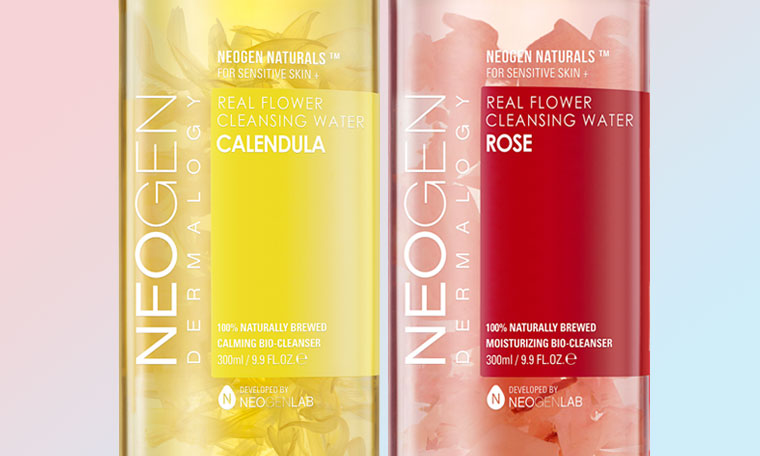Hooked on the idea of cleansing waters? You’ll be excited to know I’ve added another superstar cleansing water to the Soko Glam curation. I sneaked them in a few weeks ago before the holidays and I haven’t got around to posting my official review of them until now. Quite a few of you have snatched them up and now the reviews are starting to flow in—all five-stars! I’m really stoked because these aren’t just run-of-the-mill cleansing waters and I’m glad you guys are seeing it too. Let me explain why they made the curation grade.

What is the Neogen Real Cleansing Water?
This formula gently removes makeup and excess impurities (dirt, pollution, oil) really, really well without drying out your skin and no rinse needed afterwards. Work it into your most stubborn waterproof makeup and it’ll wipe off super cleanly with just a squirt of the cleansing water on a cotton round and a few gentle swipes directly over the skin.
How do you use this in a 10-step skin care routine?
There’s a bit of flexibility with these cleansing waters. For the routine purists, you can use this between your cleanser and toner, or in place of your toner. When you don’t have time for your entire cleansing routine, you can use this as a standalone cleanser and toner. Then you can go straight into your treatment products and moisturizers—sort of like an express cleansing step!
But because I’m all about the double cleanse, this is how I use it.
I personally use this as a makeup remover and water-based cleanse before going into the oil cleanse. I swipe a soaked cotton round across my entire face and never, ever forget my neck. There is so much makeup and gunk on the cotton round, I usually have to flip it over to the other side to make use of the clean cotton. Next, I do my oil-cleanse. It’s basically double-cleansing backwards, but it works for me! There’s nothing wrong with breaking rules if it works for you.
So what makes this cleansing water next generation?
It’s formulated for sensitive skin and specific skin conditions. There were a handful of you who mentioned that you have sensitive skin and the Neogen Real Cleansing Water works well for you (even those who did not react well to the Beauty Water!). That’s so intriguing to me because as I’ve mentioned in an earlier blog post, Neogen focuses on making the most innovative formulas that cater to sensitive skin types. ‘Sensitive’ is one of the most common skin types in Korea, which is why many of you have converted to K-beauty after noticing the products were more gentle and didn’t upset your normally reactive skin.
Smell that? After being mesmerized by the pretty petals suspended in the formula, take a long whiff of the formula. The light fragrances soothing (mmmm, aromatherapy) and smells of rose and calendula!
Although the packaging looks very simple, there is actually a very sneaky mesh filter hidden within the cap that prevents natural sediment from leaving the bottle.
Stays true to the hydration theory. As I explained in my K-beauty predictions blog post, the biggest difference I’ve seen between Korean cleansing waters vs. the popular Bioderma micellar cleansing water is that Korean cleansing waters are super hydrating and great for the skin thanks to its skin nourishing ingredients.
REAL natural ingredients. They weren’t kidding about the “real” part. There are whole calendula/rose petals suspended in the bottle to help not only sweep the impurities off the skin but also nourish it with fermented ingredients. If this is a cleansing formula that is going to sit on your skin without being washed off, I definitely want to make sure it’s actually good for it. There are two types of these cleansing waters to choose from:
I recommend this one for normal to oily/combination skin types concerned about acne.
Calendula extracts are known for its healing powers. It calms irritated skin with its anti-inflammatory properties, something sensitive skin types crave. What’s great about calendula is that it is hydrating as well so your skin doesn’t feel stripped of its natural oils.
I recommend this for normal to dry skin types concerned with anti-aging. Rose extracts are known to be extremely hydrating which will help plump and firm up the skin as antioxidants help fight free radical damage.
What I love about this, is that the third ingredient (after water and a surfactant to bind oil/water together) features the main rose or calendula extracts followed by a great blend of hydrating humectants (panthenol, hyaluronic acid) and other natural plant extracts such as cucumber and aloe—none of which are known irritants! It’s all good stuff and no bogus filler.
Both of these cleansing waters have a pH of 6, which is gentle enough for your skin while being effective at cleansing. I owe you guys a comparison review on the cleansing waters from Son & Park, Neogen and Bioderma—but for now this is it! I hope you enjoyed learning about these Neogen cleansing waters. I have a sneaking suspicion this will be a best-seller on Soko Glam. Can’t wait for you to try and hear what you think! If you’re still on the fence, shoot me questions below.
xx Charlotte


















